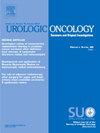高分辨率显微超声、系统经直肠超声和核磁共振成像融合活检的前列腺癌病理分级一致性。
IF 2.3
3区 医学
Q3 ONCOLOGY
Urologic Oncology-seminars and Original Investigations
Pub Date : 2025-05-01
DOI:10.1016/j.urolonc.2024.10.018
引用次数: 0
摘要
背景和目的:目前尚未开展活检策略间的比较研究,以评估根治性前列腺切除术(RP)的病理学一致性,尤其是新型微超声(micro-US)图像引导活检:这是一项回顾性研究,研究对象是在一家多医疗机构接受TRUS、MRI-TRUS融合、microUS或MRI-microUS融合活检后进行根治性前列腺切除术的PCa患者。我们根据任何活检核心中最高的 GG 值,比较了从活检到 RP 的 GG 升级情况,并使用描述性统计和多变量逻辑回归分析研究了与病理升级相关的临床/病理因素:2021年1月1日至2023年6月6日期间的429例患者,包括10例(25.6%)在RP前接受系统TRUS、237例(55.2%)MRI-TRUS、67例(15.6%)MRI-microUS和15例(3.5%)micoUS-单独活检的患者。78例(18.2%)最终病理结果升级(TRUS 31例(28.2%),MRI-TRUS 31例(13.1%),MRI-microUS 10例(14.9%),microUS:6例(40%)),99例降级。14人(3.5%)经历了重大升级(≥2 GG 增加)。多变量分析显示,与单纯 TRUS 活检相比,MRI-TRUS(几率比,OR:0.31,95% CI:0.17-0.56,P < 0.001)和 MRI-microUS(OR:0.43,95% CI:0.19-0.98,P = 0.044)均与较低的病理升级几率相关。在成对比较中,单纯 TRUS 和 microUS(P > 0.05)、MRI-microUS 和 MRI-TRUS (P = 0.696)之间的升级几率无明显差异。与 microUS 相比,MRI-microUS 的升级率较低(OR:0.26,95% CI:0.08-0.90,P = 0.034)。不同活检策略在病理降级或总体GG一致性方面无差异。结论:MRI-MicroUS和MRI-MicroUS两种活检方法在病理降级或总体GG一致性方面均无差异:结论:与TRUS活组织检查相比,MRI-microUS和MRI-TRUS融合检查同样提高了GG一致性。MicroUS单独活检与TRUS活检之间或MRI-MicroUS与MRI-TRUS融合活检之间无明显差异,这可能表明疾病取样的准确性表现相似:据我们所知,这是第一项根据活检类型调查GG一致性的研究,尤其是与RP术后GG升级相关的microUS。在一个中等规模的队列中,这是首次调查核磁共振-MicroUS融合活检与核磁共振-TRUS融合活检的病理一致性。我们的研究可能有助于泌尿科医生在活检后为患者提供咨询并选择理想的图像引导活检技术,但还需要随机对照试验来验证我们的结果。患者摘要:我们进行了一项研究,以了解前列腺活检的类型(包括使用核磁共振辅助检查以及使用更先进的超声波进行新的图像引导活检)是否能更好地识别前列腺癌患者的侵袭性。我们发现,在预测前列腺手术中发现的前列腺癌类型方面,与核磁共振成像融合的新型活检和现有的核磁共振成像引导活检类型相似。这两种方法都比传统的仅通过超声波进行活检更准确。本文章由计算机程序翻译,如有差异,请以英文原文为准。
Pathologic prostate cancer grade concordance among high-resolution micro-ultrasound, systematic transrectal ultrasound and MRI fusion biopsy
Background and Objective
Comparative studies among biopsy strategies have not been conducted evaluating pathologic concordance at radical prostatectomy(RP), especially with novel micro-ultrasound (micro-US) image-guided biopsy.
Methods
A retrospective study among patients with PCa who underwent RP following TRUS, MRI-TRUS fusion, microUS, or MRI-microUS fusion biopsy in a multi-site single institution. We compared GG-upgrade from biopsy to RP based on highest GG in any biopsy core and examined clinical/pathologic factors associated with pathologic upgrading using descriptive statistics, and multivariable logistic-regression analysis.
Results
429 patients between 1/2021 and 6/2023 including 10 (25.6%) who underwent systematic TRUS, 237 (55.2%) MRI-TRUS, 67 (15.6%) MRI-microUS and 15 (3.5%) micoUS-alone biopsy prior to RP. 78 (18.2%) were upgraded on final pathology (TRUS 31 (28.2%), MRI-TRUS 31 (13.1%), MRI-microUS 10 (14.9%), microUS: 6 (40%)) and 99 downgraded. 14 (3.5%) experienced a major upgrade (≥2 GG increase). On multivariable-analysis both MRI-TRUS (odds ratio, OR: 0.31,95% CI:0.17–0.56, P < 0.001) and MRI-microUS (OR: 0.43,95%CI: 0.19–0.98, P = 0.044) were associated with lower odds pathological-upgrade compared with TRUS biopsy alone. No significant differences in the odds of upgrade between TRUS and microUS alone (P > 0.05), or between MRI-microUS and MRI-TRUS(P = 0.696) on pairwise comparisons. MRI-microUS was associated with lower upgrade compared with microUS (OR: 0.26,95% CI:0.08–0.90, P = 0.034). No difference among the biopsy strategies in pathologic downgrading or overall GG concordance. Limitations include retrospective analysis, inter-clinician experience and lesion selection in varying biopsy techniques.
Conclusion
Both MRI-microUS and MRI-TRUS fusion were associated with similarly improved GG concordance compared with TRUS biopsy. No significant differences between microUS-alone and TRUS or between MRI-microUS and MRI-TRUS fusion approaches, may suggest similar accuracy performance for disease sampling.
What does the study add
To our knowledge, this is the first study to investigate GG concordance based on type of biopsy, especially microUS related GG upgrading after RP. In a moderately sized cohort this is the first to investigate pathologic concordance in MRI-microUS fusion compared to MRI-TRUS fusion biopsy. Our study may help urologists in counseling patients after biopsy and choosing the ideal image guided biopsy technique, however randomized controlled trials are needed to validate our results.
Patient Summary
We performed a study to see if the type of prostate biopsy, including use of MRI assistance as well as a new image-guided biopsy using a more advanced ultrasound, was better able to identify the aggressiveness of prostate cancer patients had. We found that the new biopsy type when fused with MRI and the existing MRI-guided biopsy type were similar in predicting the type of prostate cancer found at prostate surgery. These were both more accurate than the conventional ultrasound only biopsy.
求助全文
通过发布文献求助,成功后即可免费获取论文全文。
去求助
来源期刊
CiteScore
4.80
自引率
3.70%
发文量
297
审稿时长
7.6 weeks
期刊介绍:
Urologic Oncology: Seminars and Original Investigations is the official journal of the Society of Urologic Oncology. The journal publishes practical, timely, and relevant clinical and basic science research articles which address any aspect of urologic oncology. Each issue comprises original research, news and topics, survey articles providing short commentaries on other important articles in the urologic oncology literature, and reviews including an in-depth Seminar examining a specific clinical dilemma. The journal periodically publishes supplement issues devoted to areas of current interest to the urologic oncology community. Articles published are of interest to researchers and the clinicians involved in the practice of urologic oncology including urologists, oncologists, and radiologists.

 求助内容:
求助内容: 应助结果提醒方式:
应助结果提醒方式:


